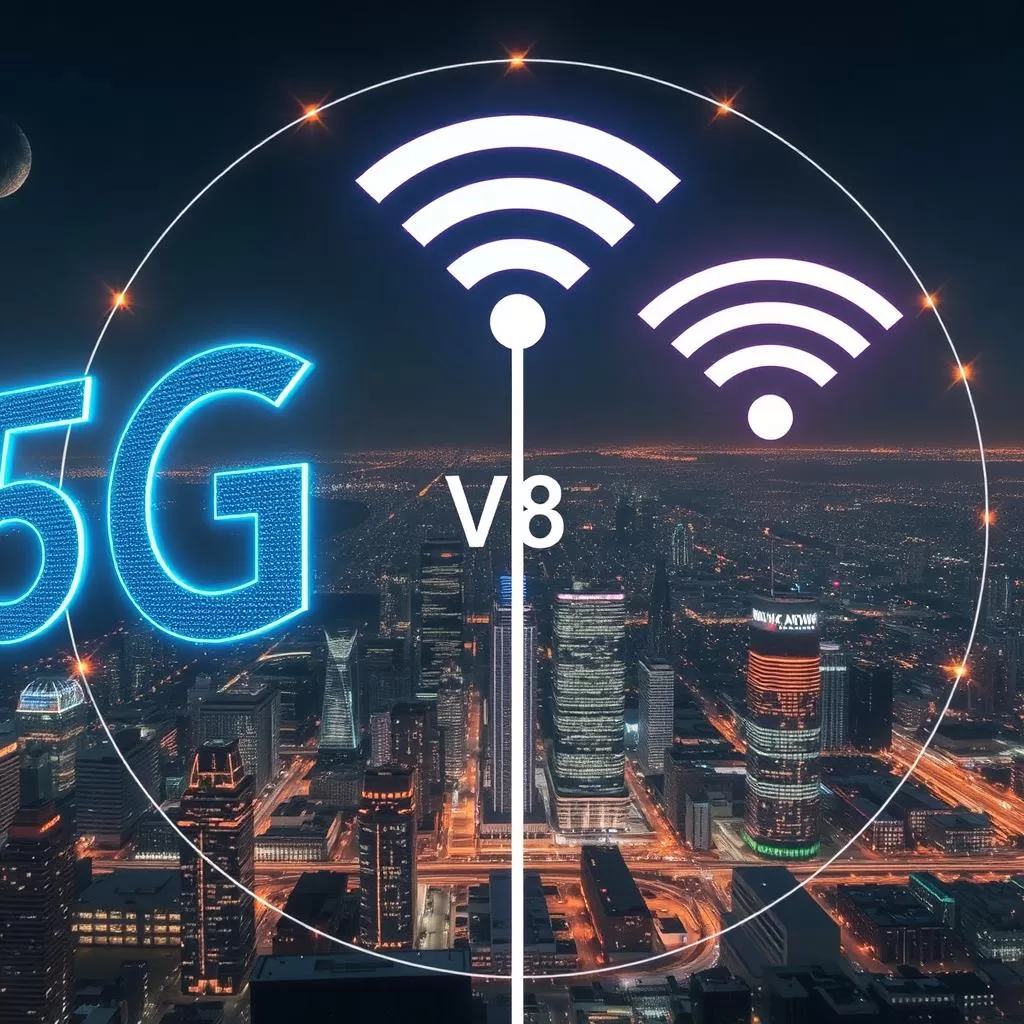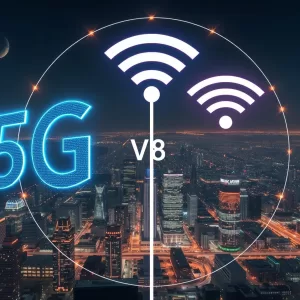5G and Wi-Fi 6: Which One Will Dominate the Future of Wireless Connectivity?
The demand for high-speed, low-latency internet is growing as more devices connect to the digital world. Two major wireless technologies—5G and Wi-Fi 6—are leading this transformation.
But which one is better? Will 5G replace Wi-Fi, or will they coexist? This article explores the key differences, advantages, and future trends of both technologies.
What You’ll Learn in This Article:
✅ How 5G and Wi-Fi 6 work and their key differences
✅ The best use cases for 5G vs. Wi-Fi 6
✅ Whether 5G will replace Wi-Fi in the future
What is 5G?
5G, short for Fifth Generation Wireless Technology, represents the next leap forward in mobile connectivity. Building on the foundation laid by its predecessors (4G, 3G, and so on), 5G offers a dramatic improvement in speed, responsiveness, and the number of devices that can connect simultaneously.
First and foremost, 5G delivers blazing-fast speeds—reaching up to 10 gigabits per second (Gbps). That means downloading a full-length HD movie in just seconds or streaming ultra-high-definition video with zero buffering.
Moreover, latency is significantly reduced, dropping to as low as 1 millisecond. This near-instantaneous responsiveness is crucial for emerging technologies like autonomous vehicles, remote surgery, and real-time online gaming.
In addition to speed and latency, 5G is designed for massive connectivity. It can support up to 1 million devices per square kilometer, making it ideal for smart cities, Internet of Things (IoT) ecosystems, and high-density public events.
In short, 5G isn’t just about faster smartphones—it’s about enabling a smarter, more connected world.
🔹 How 5G Works:
To deliver its ultra-fast speeds and low-latency performance, 5G taps into a mix of frequency bands—each playing a unique role in the network.
At the high end of the spectrum are millimeter waves (mmWave). These frequencies offer the fastest data speeds and highest capacity, perfect for dense urban areas or stadiums. However, mmWaves have a shorter range and can be easily blocked by obstacles like buildings and trees.
To strike a balance between speed and coverage, mid-band frequencies come into play. They provide a solid mix of performance and reach, making them ideal for suburban and citywide deployment.
Finally, low-band frequencies offer broad coverage and strong signal penetration, even indoors. While they don’t deliver the same blistering speeds as mmWave, they ensure reliable connectivity in rural areas and deep inside buildings.
By intelligently combining these three frequency bands, 5G creates a layered network that adapts to different environments—ensuring fast, stable, and widespread coverage for users everywhere.
💡 For example, telecom companies like Verizon, AT&T, and T-Mobile are expanding 5G networks to support smart cities, autonomous vehicles, and AR/VR applications.
🔗 Related: Top 10 Emerging Technologies in 2025
What is Wi-Fi 6?
Wi-Fi 6, also known as 802.11ax, is the latest generation of Wi-Fi technology—designed to meet the growing demands of modern connected life. As more smart devices fill our homes, offices, and public spaces, Wi-Fi 6 steps in to deliver faster, smarter, and more efficient wireless performance.
To begin with, Wi-Fi 6 offers impressive speeds, reaching up to 9.6 Gbps. While that’s more than enough for even the most demanding tasks—like 4K video streaming, online gaming, or large file transfers—it’s not just about raw speed.
One of the biggest advantages of Wi-Fi 6 is its ability to perform better in crowded environments. Whether you’re at a busy airport, in a packed stadium, or just living in a smart home full of connected gadgets, Wi-Fi 6 is built to handle more devices simultaneously without slowing down.
Additionally, Wi-Fi 6 is more energy-efficient. It reduces power consumption in connected devices—meaning your smartphone, tablet, or laptop can stay connected longer without draining the battery.
In essence, Wi-Fi 6 isn’t just an upgrade in speed—it’s a smarter, more efficient way to stay connected in a hyper-connected world.
🔹 How Wi-Fi 6 Works:
So, how does Wi-Fi 6 manage to be faster, smarter, and more efficient? The magic lies in two key technologies: Orthogonal Frequency Division Multiple Access (OFDMA) and Target Wake Time (TWT).
First, OFDMA is a game changer when it comes to efficiency. Traditional Wi-Fi handles one device at a time per channel, but OFDMA allows Wi-Fi 6 to divide a single channel into smaller sub-channels. This means it can serve multiple devices simultaneously, reducing latency and improving performance—especially in crowded networks like smart homes, offices, or public spaces.
Then there’s Target Wake Time (TWT), which focuses on power efficiency. TWT schedules when devices should wake up to send or receive data, allowing them to remain in low-power mode when not in use. The result? Better battery life for smartphones, tablets, smartwatches, and IoT devices.
By combining these technologies, Wi-Fi 6 creates a more streamlined, efficient wireless experience—handling more devices with less congestion and conserving power along the way.
💡 For example, airports, stadiums, and large offices use Wi-Fi 6 to provide stable connections to thousands of users simultaneously.
5G vs. Wi-Fi 6: Key Differences
While both 5G and Wi-Fi 6 represent the cutting edge of wireless technology, they serve different purposes and excel in different environments. Here’s a quick breakdown of how they compare:
| Feature | 5G | Wi-Fi 6 |
|---|---|---|
| Primary Use | Mobile networks (cell towers) | Local wireless networks (homes, offices) |
| Speed | Up to 10 Gbps | Up to 9.6 Gbps |
| Latency | As low as 1 millisecond | Very low, but slightly higher than 5G |
| Coverage | Wide-area, outdoor mobility | Short-range, indoor environments |
| Device Connectivity | Up to 1 million devices per sq. km | Optimized for dense device environments |
| Power Efficiency | Efficient for mobile networks | TWT reduces device battery usage indoors |
| Infrastructure | Requires cellular towers and carrier support | Operates through local routers and access points |
Will 5G Replace Wi-Fi?
5G and Wi-Fi 6 aren’t competitors—they’re complementary technologies.
If you’re on the move, especially in outdoor environments or switching between locations, 5G is your go-to. It provides the speed and mobility needed for real-time apps, autonomous systems, and staying connected anywhere.
On the other hand, when you’re indoors—whether at home, work, or in a public venue—Wi-Fi 6 offers a faster, more reliable, and energy-efficient connection without using up your mobile data.
In short:
✅ 5G = Outdoor mobility
✅ Wi-Fi 6 = Indoor connectivity
🔹 Where 5G is Better:
5G truly shines in environments that demand high-speed, low-latency, and massive device connectivity. Here are a few areas where 5G outperforms other technologies:
✔ Autonomous Vehicles – For self-driving cars to navigate safely and make real-time decisions, they need lightning-fast communication between vehicles, sensors, and infrastructure. 5G’s ultra-low latency (as low as 1 millisecond) ensures that data can be processed almost instantly, enabling vehicles to react to obstacles and changes in the environment without delay.
✔ Smart Cities & IoT – Imagine a city with connected traffic lights, smart meters, security cameras, and countless other devices all communicating in real-time. 5G can support up to 1 million devices per square kilometer, making it the perfect network for powering the Internet of Things (IoT). This level of connectivity is crucial for the development of smart cities—where everything from waste management to emergency response relies on seamless data flow.
✔ Remote Work & Mobile Devices – As more people work remotely, the need for reliable, high-speed internet on the go becomes essential. 5G provides a consistent, high-speed connection even in crowded areas like airports, coffee shops, or urban centers—ensuring that you can stay productive and connected from almost anywhere. Whether you’re on a video call, accessing cloud-based files, or collaborating in real-time, 5G ensures you’re always a step ahead.
🔹 Where Wi-Fi 6 is Better:
While 5G excels in outdoor mobility and large-scale connectivity, Wi-Fi 6 is built to provide optimal performance in localized environments, especially where high-speed, high-capacity connections are needed indoors. Here’s where Wi-Fi 6 truly stands out:
✔ Homes & Offices – Wi-Fi 6 is the perfect solution for local area networks in residential and business settings. It offers faster speeds, better efficiency, and less congestion—making it ideal for homes filled with smart devices or offices with many connected employees. Plus, Wi-Fi 6 is more cost-effective than 5G for indoor connectivity, as you don’t need cellular infrastructure—just a Wi-Fi 6 router.
✔ Public Areas (Airports, Malls, Stadiums) – In crowded spaces where thousands of people need to connect to the internet at once, Wi-Fi 6 shines. It can handle a high volume of devices simultaneously without causing slowdowns or interruptions. Thanks to technologies like OFDMA, it can serve multiple users efficiently, ensuring that you can enjoy stable connections even in the busiest environments.
✔ Streaming & Gaming – For activities that demand high-bandwidth and low-latency connections—like streaming 4K video or playing online games—Wi-Fi 6 is the ideal choice. It provides stable, high-speed connectivity, which is crucial for uninterrupted experiences. Whether you’re binge-watching your favorite show or competing in a fast-paced online game, Wi-Fi 6 ensures smooth, lag-free performance.
💡 Example: A company may use Wi-Fi 6 inside the office and 5G for remote workers.
🔗 Related: How AI is Revolutionizing Fintech
Future Trends: 5G and Wi-Fi 7
As we look ahead, both 5G and Wi-Fi 7 are poised to revolutionize the way we connect and interact with technology. Here’s a glimpse into the future of wireless connectivity:
🚀 Wi-Fi 7 (802.11be) – The next evolution in Wi-Fi technology, Wi-Fi 7 promises to bring speeds of up to 30 Gbps—three times faster than Wi-Fi 6! This leap in speed and performance will make it ideal for high-demand applications like 8K video streaming, virtual and augmented reality, and high-frequency trading. Wi-Fi 7 will also improve latency and multi-device performance, making it a major upgrade for smart homes and large-scale business networks.
🚀 5G Expansion – The rollout of 5G networks is just the beginning. As coverage expands, we can expect smart cities to flourish, powered by 5G’s high-speed, low-latency capabilities. Artificial Intelligence (AI) will play a key role in optimizing network performance, enabling real-time decision-making for everything from traffic management to emergency response. Edge computing, which brings computing resources closer to the user, will also thrive on 5G—further reducing latency and improving data processing speeds.
🚀 Hybrid 5G + Wi-Fi Solutions – The future will see devices seamlessly switching between 5G and Wi-Fi 7 networks based on location and network availability. For example, when you’re out and about, your phone will tap into 5G for mobile connectivity, but when you’re back home, it’ll automatically switch to Wi-Fi 7 for ultra-fast speeds. This hybrid approach will ensure that users get the best of both worlds—optimized speed, coverage, and reliability.
With these future trends, we’re entering a new era of connectivity, where speed, efficiency, and seamless experiences will define how we interact with the digital world. Exciting times are ahead!
💡 Example: Wi-Fi 7 is expected to launch in 2025, bringing even faster speeds and better network efficiency.
Conclusion: The Future of Wireless Connectivity
As we move forward, both 5G and Wi-Fi 6 will play pivotal roles in transforming the way we connect, communicate, and interact with technology. Rather than competing, these two advanced technologies will complement each other, creating a more seamless and efficient digital ecosystem.
5G will continue to drive mobility, offering ultra-fast, low-latency connections for autonomous vehicles, smart cities, and remote work. Its ability to handle massive device connections and provide high-speed internet in outdoor environments will be a game-changer in industries ranging from transportation to healthcare.
Meanwhile, Wi-Fi 6 will dominate indoor environments, ensuring that homes, offices, and public spaces can support the growing number of connected devices. Its superior speed, efficiency, and performance in crowded areas will be essential as we embrace smarter, more connected lifestyles.
In the future, 5G and Wi-Fi 6 will work in harmony, with devices intelligently switching between networks based on location, ensuring fast, stable, and reliable connectivity at all times. Whether you’re on the go with 5G or at home enjoying the power of Wi-Fi 6, the future of wireless connectivity promises to be faster, more efficient, and more integrated than ever before.
🔹 Ready to Embrace the Future of Connectivity?
At Teknikali Tech, we specialize in helping businesses and individuals stay ahead of the curve with the latest in wireless technology. Whether you’re looking to implement 5G solutions, optimize your Wi-Fi networks, or build a robust IoT infrastructure, our expert ICT consultancy services are designed to guide you every step of the way.
Don’t get left behind—embrace the future of digital connectivity with Teknikali Tech.
Explore how we can help you future-proof your network today:
Teknikali Tech ICT Consultancy
Key Takeaways:
✅ 5G is best for mobility, IoT, and large-scale outdoor applications.
✅ Wi-Fi 6 is better for homes, businesses, and high-density areas.
✅ Future technologies (Wi-Fi 7 and 6G) will further improve wireless networks.
💬 Which technology do you prefer—5G or Wi-Fi 6? Share your thoughts in the comments!
Share this content:













Post Comment